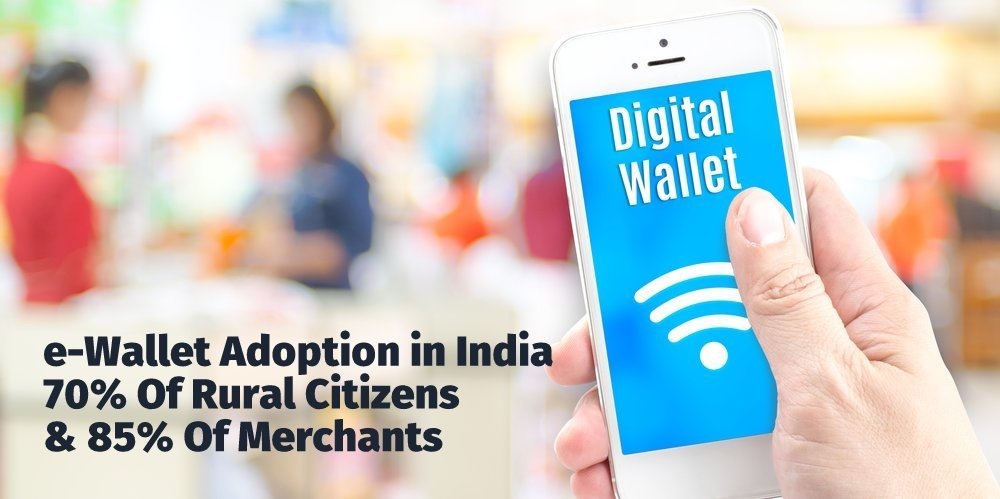Govt Claims 70% Of Rural Citizens & 85% Of Merchants Have Adopted E-Wallets; But Average Transaction Value Decreases

Government of India’s initiatives to teach, encourage and inspire rural population about cashless economy is bringing in massive results.
As per latest data shared by Electronics and IT Ministry, it was revealed that e-Wallets are right now the #1 choice for majority of buyers and sellers, followed by UPI based payments, USSD based payments and Aadhaar Enabled Payment System (AEPS).
In fact, 70% of all rural population across India is right now using e-Wallets to make their payments, while 16% are using UPI based payment mechanism. At the same time, 85% of all merchants are using e-wallets to receive payments. UPI based payments is being used by 13% of merchants pan-India.
MeitY Secretary Aruna Sundararajan said, “The speed and scale at which digital transformation in taking place in India is paving the way for a digitally empowered, participative and inclusive society,”
Triggers For Cashless Economy
These spectacular results for adopting cashless economy is being driven by grass-root work done by Govt. of India, ever since demonetization kicked in.
For instance, under Common Service Centre (CSC) network across villages, 25 lakh rural citizens have enrolled themselves for digital payments. And as a direct result, 55,000 merchants active in rural areas have started accepting digital mode of payments.
This is plain and simple network effect of spreading an idea, the same principle which propelled astronomical expansion of Whatsapp and Facebook over the years. Once your friends and family are on a network, then you have to be included. The same with rural economy is now happening: Once the buyers are getting into the cashless mode, the sellers have to be.
Aruna further said, “Achieving the 25 lakh mark in such a short time is an indication of the pace at which digital adoption is gaining momentum among rural citizens.”
Besides, The DigiDhan Abhiyan, which provides education and awareness about cashless mode of payments is aiming to reach 1 crore+ rural citizens in the next 12 months, as it covers more than 2 lakh Common Service Centres across India and convince more than 2.5 lakh Gram panchayats across the country.
But Value of Card Based Transactions Falls Below Expectations
Meanwhile, another report by SBI Research states that although the volume of card based transactions (happening at PoS terminals) have increased, their combined value has decreased since November 8th.
In fact, the dip in the value of card based transactions is at a 9-month low.
In November, 2016, total of Rs 35,240 crore was spent using cards at PoS terminals all over India, which is the lowest since February, 2016 (it was Rs 33,600 crore then).
Interestingly, from February to October, the value of card based transactions grew at an amazing pace: from Rs 33,600 crore in February to Rs 51,116 crore in October.
But after the demonetization move, the growth suddenly slowed down.
If Rs 2249 was the average transaction amount at PoS terminals, it fell down to Rs 1714 in November.
It seems that the drop has happened mainly due to the false alarm of slowing down economy, and people hoarding up their money.
Explaining the slowdown in November and December, Soumya Kanti Ghosh, group chief economic adviser of State Bank of India said, “Decline in consumption could be one of the possible reasons as people were uncertain about spending after the announcement was made. Even December figures look down and we need to see how it can be improved because it could otherwise have an impact on growth.”
The report also highlighted the fact there are 15.1 lakh PoS terminals in India right now, and we need 20 lakh more terminals for promoting digitization of payments.
As per SBI Research, effects of demonetization will stabilize after January, as more currency seeps into the system, and people start spending like before.

#cashless or #lesscash will increase when :
(1) Nil bank charges for annual/monthly maintenance for Debit/ATM cards
(2) No any Merchant commission will charged from seller
(3) No any extra cost/charge will be levied on purchase through Debit card
(4) Instead 0.75% discount will be given for forever on transaction thru Debit card
(5) All Nationalised banks must issue only RUPAY cards to customers. No Visa or Mastercard etc. global companies cards, so that Indian Money shall not outflow from India.
(6) RUPAY Debit/credit cards should made global, so that it can be given by foreign banks to theire customers in foreign countries and India can get transaction commission (cheaper may be 0.50 paise only per transaction), so that foreign money in inflow in India.